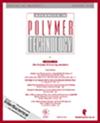A Modified Hydrolysis Method of Decolorizing Reactive-Dyed Polycotton Waste Fabric and Extraction of Terephthalic Acid: A Perspective to Reduce Textile Solid Waste
IF 2
4区 工程技术
Q3 ENGINEERING, CHEMICAL
引用次数: 1
Abstract
To manage the polycotton textile-waste fabric (PCWF), a modified alkaline hydrolysis method is used for decolorization and separation of polyester as terephthalic acid (TPA). The effects of optimum conditions on TPA yield (%) have been determined to be 97.66 ± 1.94 % . Dye degradations and K/S values are measured by UV-visible spectrophotometer. K/S value of PCWF is 37.06 and separated cotton fabric (SCF) is 0.035, respectively. The chemical functionalities and crystallinity of PCWF, SCF, and TPA are determined by using FTIR and XRD. FTIR peak values are 1684 cm-1, 1574 cm-1, 1512 cm-1, 1280 cm-1, and 1425 cm-1 that prove transformation of polyester to TPA. XRD peaks confirm polyester conversion to TPA, and the values are 17.4, 25.13, 28.12, 29.09, and 38.7. TGA, SEM, and EDX data showed the thermal stability, morphology, and elemental composition of TPA.改性水解脱色活性染色涤棉废织物及提取对苯二甲酸:减少纺织固体废物的前景
针对涤棉纺织废织物(PCWF)的处理问题,采用改进的碱水解法对涤纶进行脱色分离,得到对苯二甲酸(TPA)。最佳工艺条件对TPA产率(%)的影响为97.66±1.94%。用紫外可见分光光度计测定染料降解率和K/S值。PCWF的K/S值为37.06,分离棉(SCF)的K/S值为0.035。采用FTIR和XRD对PCWF、SCF和TPA的化学官能团和结晶度进行了测定。FTIR峰值分别为1684 cm-1、1574 cm-1、1512 cm-1、1280 cm-1和1425 cm-1,表明聚酯向TPA转化。XRD峰值分别为17.4、25.13、28.12、29.09和38.7,证实聚酯转化为TPA。TGA, SEM和EDX数据显示了TPA的热稳定性,形貌和元素组成。
本文章由计算机程序翻译,如有差异,请以英文原文为准。
求助全文
约1分钟内获得全文
求助全文
来源期刊

Advances in Polymer Technology
工程技术-高分子科学
CiteScore
5.50
自引率
0.00%
发文量
70
审稿时长
9 months
期刊介绍:
Advances in Polymer Technology publishes articles reporting important developments in polymeric materials, their manufacture and processing, and polymer product design, as well as those considering the economic and environmental impacts of polymer technology. The journal primarily caters to researchers, technologists, engineers, consultants, and production personnel.
 求助内容:
求助内容: 应助结果提醒方式:
应助结果提醒方式:


